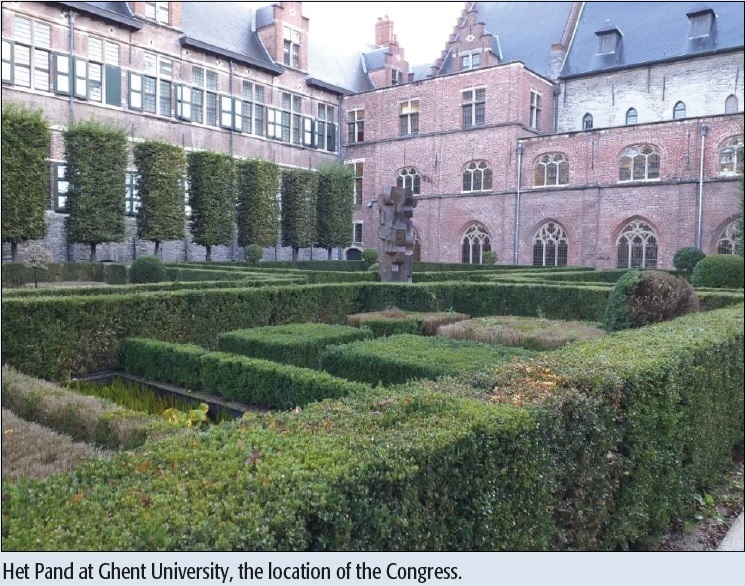
FITCE is a federation of national associations in each of its 10 member countries and is a Sister Society of the IEEE Communication Society (ComSoc). It allows its members to keep in touch with leading ICT developments and aspires to build strong cultural and business ties between European ICT (Information and Communications Technology) professionals. This is achieved by encouraging members to benefit from the experience acquired by other members in all ICT fields and in particular provide support to young professionals as they develop their careers.
FITCE organises an annual congress for improving information and knowledge exchange, communication, networking and relationships across members. This year’s conference was held in Ghent and is described here, together with an overview of the activties of national organisations.
The FITCE Conference
The 58th FITCE congress was organized jointly with CTTE and held in Het Pand, part of the University of Ghent. There were 113 delegates from 14 countries, who enjoyed six technical sessions delivering 22 papers, three keynote speeches and a provocative panel session. The Congress was opened with welcomes from Prof. Piet Demeester (Ghent University), Raf Meersman (President of FITCE Belgium), and Dr. Stefan Rugel (President of FITCE Europe).

In her keynote speech, Sofie Bracke, of the City of Ghent, described the evolution of the field and the contribution from the commercial sector, the universities, the city and the Flemish government. Danny Goderis took the audience through some real examples of Smart City initiatives, including a program networking 200,000 meters in Antwerp and adding intelligence to the process of refuse collection. Stefan Rugel spoke about the globalized nature of the market, the role of strategic road maps and a data driven strategy and the citizen centric approach.
The first technical session covered 5G for Smart Cities, with the first paper covering a smarter city in Luxembourg, enhanced by the launch of 5G. This was followed by a paper that considered using the Viterbi decoding trellis approach to find the most effective investment approach to deployment of 5G. Andrea Penza, from Italy, then described architectures for 5G, including the use of terrestrial broadband technology as base station backhaul. Finally the joint-rollout of FTTH and smart city fibre networks as a way to reduce rollout cost was discussed.
Smart Energy was the focus of the second technical session, first examining GIS based planning of broadband power line communication networks for smart metering. In the second paper a team from Deutsche Telekom addressed why and how a Telco enters the e-mobility market. IoT enabling technologies for extreme connectivity smart grid applications was the subject of the third contribution. Finally the techno-economic analysis of residential thermal flexibility for demand side management, within a smart grid deployment and the role of demand aggregation, was examined.
The focus of the third session was data for and by smart cities, and began with a paper covering the role of smart 3D mapping in providing the smart city. Two papers covering privacy followed: The first considered the role that enhancing collaborative transparency in the regulatory ecosystem played in establishing smart city privacy; the second described the social construction of personal data protection in smart cities. The road to data-driven local government was next examined.
The definition and adoption of the smart city was the topic of the next session, beginning with an Anglo-Italian paper covering a closer look at the future of smart cities. The next contribution asserted that being a smart city is not the goal and asked the question what is? The next topic examined the adoption of cooperative intelligent transport systems in Flemish passenger cars and incorporated a review of European policy options. The session concluded with a description of the “maker movement” in Belgium.
A panel session debated shaping the smart city, with reference to four use cases: the Alkmaar smart city, re-building the old docklands in Ghent, historical investment patterns and the influence of physical architecture. The panel concluded that we must make our smart future together, that the environment is of prime importance and that new commercial models must give back to the city.
The final day began by examining business models, initially looking at getting investment for a smart waste management project in Copenhagen. City strategies for a 5G small cell network on light poles were examined next. In the “City of Things”, the improvements in mobility around a city, the environment and public spaces, stimulation of the local economy and benefits to both citizens and visitors were examined.
Techno-economics for smart cities were considered, starting with the assessment of CAPEX and OPEX for media services in cloud enabled 5G networks, within a stadium environment. Serendipity for smart cities, industries and rural areas was examined next, particularly with respect to demographics, globalization, consensus complexity, sustainability and disruptive technologies. The cost model for a 5G light pole system was then described.
The conference conclusions were that technology is not the main driver for the smart city, but a necessary enabler; legislation, regulation and privacy also have a big impact. The economics are a major concern, specifically when up scaling from pilots is concerned, and from a social perspective citizens are key. The physical impact of the architecture of the city needs to be considered when planning a smart city.